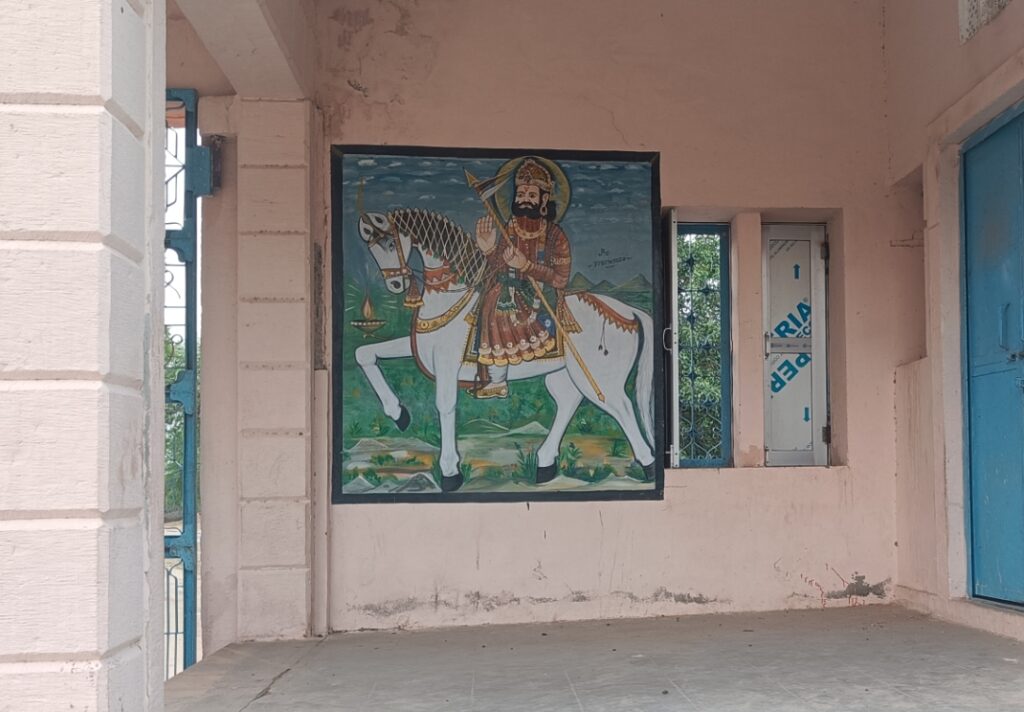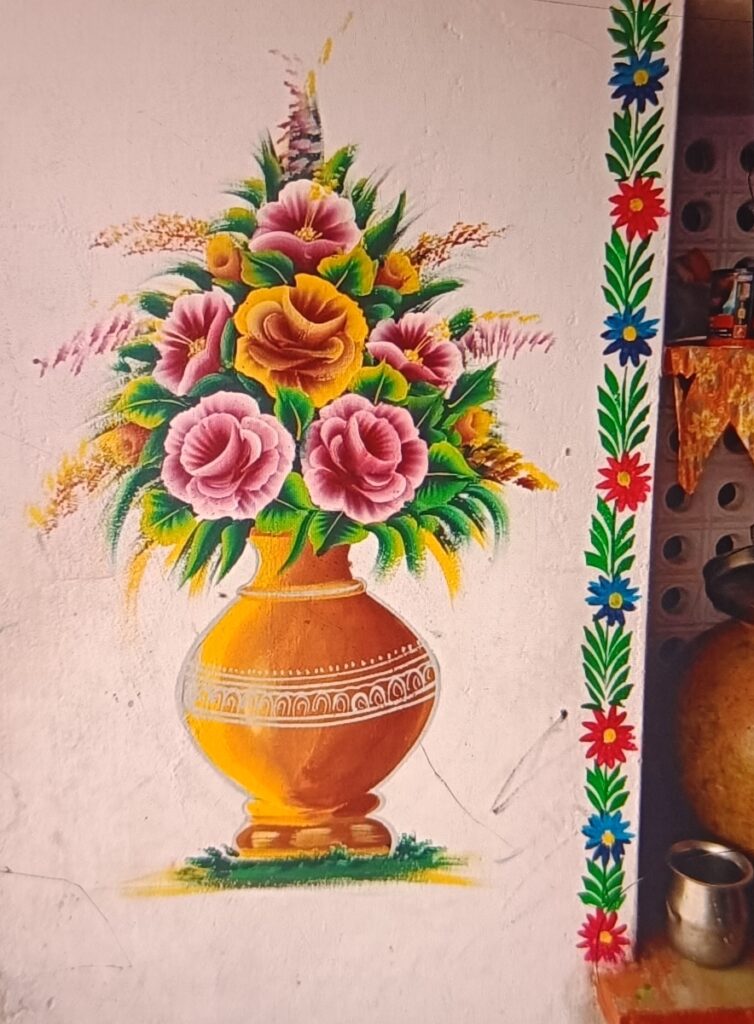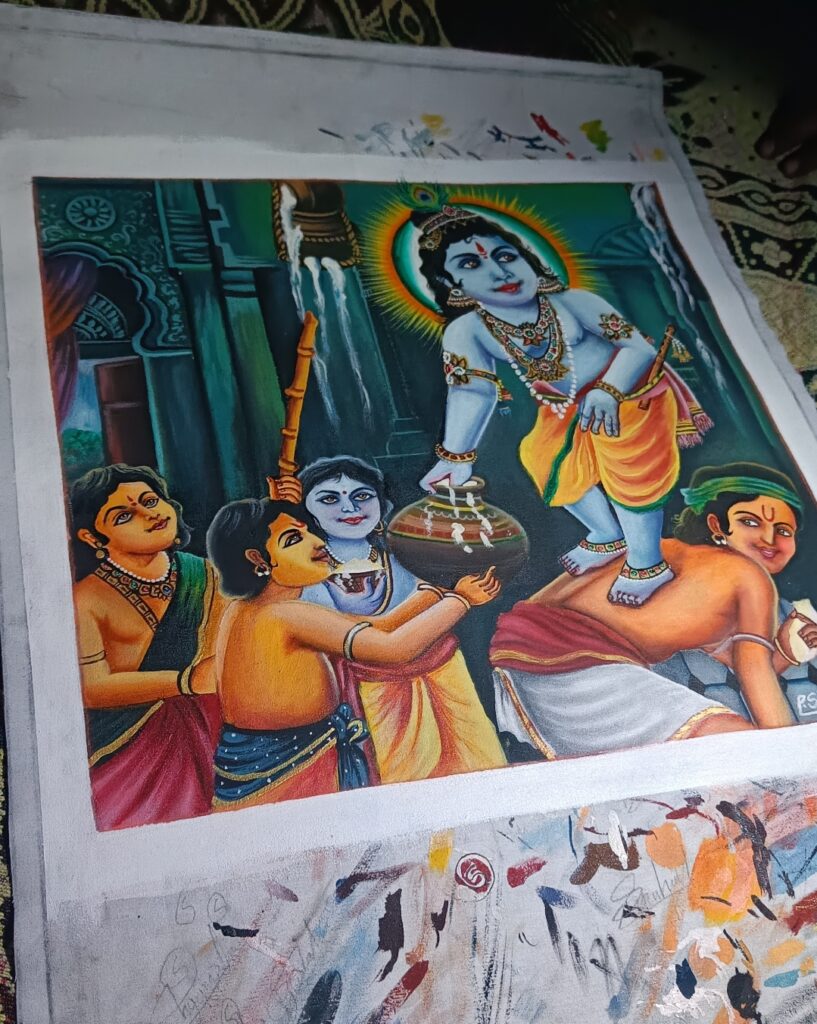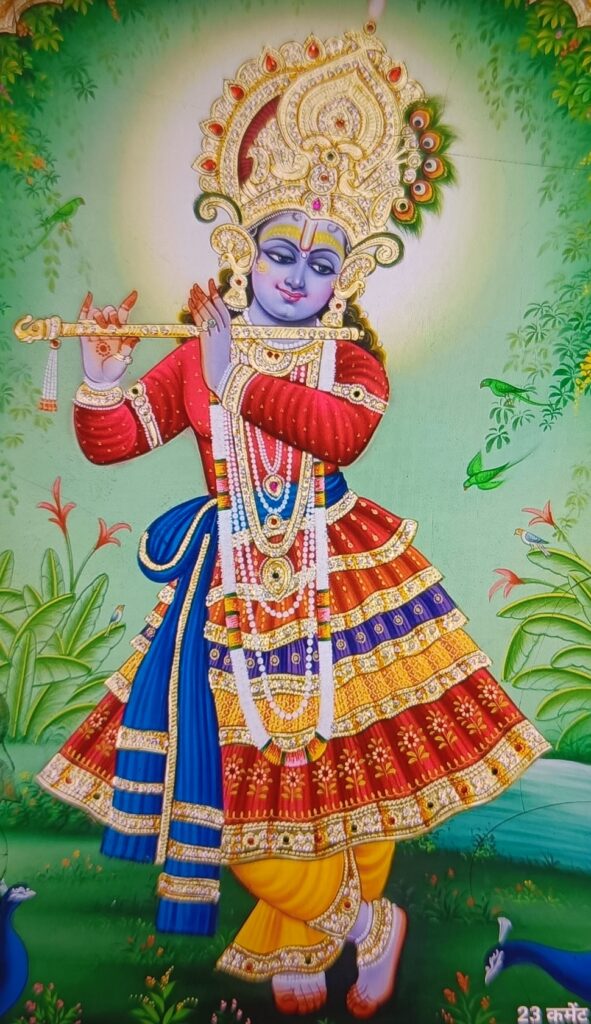What it takes to become a local wall painting artist in a village?
We often encounter intricate paintings adorning the walls of temples and signboards in Indian villages, seemingly printed but crafted by skilled artists. Yet, their artistry often remains overlooked or overshadowed by the primary subjects like temples or shops.
During my extensive cycling journey across India, this intriguing aspect of artistry and its creators became a focal point of my curiosity. I had the pleasure of meeting Shyamlal Bavri, a remarkably talented artist from Bhumbliya village in Rajasthan. While admiring a wall painting in a temple, I couldn’t help but wonder about the gifted individual behind such creations.
Upon learning that there was indeed a talented artist responsible for these remarkable paintings, I extended an invitation to Shyamlal Bavri to visit the temple where I was staying. Our ensuing conversation shed light on the challenges faced by artists in rural areas. Often, due to a lack of mentors and proper guidance, they find themselves reinventing the wheel, seeking to perfect their craft.
Shyamlal shared valuable insights, emphasizing the importance of learning the art itself rather than relying solely on readily available creations. He likened this approach to learning the art of fishing rather than simply being served a meal—an embodiment of the adage that mastering the process is equally if not more important than the outcome. This encounter underscored the rich tapestry of talent and innovation that thrives in the lesser-known corners of our diverse nation.

What makes one become a wall painting artist in a village?
Mr. Shyamlal, hailing from a family deeply rooted in farming, faced resistance and discouragement when he embarked on the journey of learning sketching and painting. In a household where the focus was on manual labor, investing time in art was seen as unproductive. However, Shyamlal’s fascination for sketching began at a tender age, igniting a passion that couldn’t be dampened.
In the 3rd grade, a pivotal moment occurred when he laid eyes on a friend’s book filled with bird pictures. Borrowing it for a day, he stayed up all night sketching over 50 bird illustrations, with the eagle being his initial creation. Despite not being perfect, the joy derived from the process fueled his determination.
For the next few years, Shyamlal honed his skills, receiving requests from friends to sketch their portraits and various subjects. By the time he reached the 8th grade, he had become a proficient artist, showcasing a promising talent.
Navigating the traditional customs of his Bavri caste, Shyamlal was engaged at the age of 11, and by the 8th grade, he was married. Adapting to the responsibilities of a married life, he saw an opportunity in painting the walls of houses during weddings—an established tradition. This marked the beginning of his journey to sustain himself and provide for his family, leveraging his developed artistic skills. Remarkably, he began earning up to 25,000 rupees, a significant sum at that time, doing what he loved.
Initially met with skepticism from people who believed there was no future in painting, Shyamlal’s persistence and talent eventually proved the naysayers wrong. Today, he proudly paints for more than 100 villages, a testament to his resilience and passion for art.
The scope of wall painting artist in a village?
During our conversation, Shyamlal shared that a surge in painting requests occurs during the bustling wedding season in November. This is the time when houses are adorned with vibrant floral and decorative paintings on their walls. Additionally, there’s a consistent demand for painting signboards and advertisements on walls.
To provide a glimpse into the effort involved, Shyamlal mentioned that crafting a mural on a house wall during a wedding typically takes around 3-4 hours of dedicated work. For this artistic endeavor, he said that he charges approximately 500 rupees.

In addition to wall paintings, Shyamlal revealed that he receives requests for wall hangings, a craft he prices at around 5000 rupees and above. Completing a wall hanging involves an investment of about 5 days of meticulous work. His continuous pursuit of growth and skill refinement is evident, as he constantly challenges himself to delve deeper into various art forms.

In his precious moments of leisure, Shyamlal has ventured into fabric painting and Tanjore paintings, a form of gold embroidery. Some of these intricate paintings fetch upwards of 30,000 rupees due to their exquisite craftsmanship. He emphasized his eagerness to explore new projects and collaborate with diverse individuals, recognizing the immense learning potential that arises from mastering different art forms to meet a variety of requests and commissions.
Shyamlal shared a keen observation about the traditional learning patterns of artists in different villages. Typically, painters in various regions specialize in one specific art form, learning it exclusively from designated teachers. However, breaking free from this limitation, Shyamlal takes pride in his self-driven approach, embracing the challenge to learn multiple art forms independently. This boundless learning ethos fuels his aspiration to amass a rich repertoire of artistic expressions.

Shyamlal expressed the immense joy of being able to work from the comfort of his home, underscoring how this aspect enriches the quality time he spends with his family. For him, this is one of the most gratifying aspects of being a painter in a village—having the freedom to balance work and family.
In a heartwarming testament to passing down the artistry, Shyamlal’s cousin currently works alongside him, eager to learn and master the art of wall painting. The tradition of imparting skills and knowledge within the family is being carried forward, potentially nurturing another artist who aims to establish a career in this craft.
Mindset of a wall painting artist in a village
It was unequivocally clear that Shyamlal was not just an artist driven by monetary gains. He possessed an insatiable thirst for furthering his skills and an innate ambition to excel in his craft. One outstanding testament to this drive was his successful completion of a Bachelor of Arts degree—an achievement that held significant personal importance. He proudly proclaimed to be the first from his community (samaj) to attain this educational milestone, driven by a desire to set an example.
Even with the certainty of a full-time artistic career ahead of him, Shyamlal pursued this academic goal, showcasing the kind of determination that often translates into exceptional talent. His dedication to education was a reflection of his relentless drive to be the best at what he does.
One particular instance that shed light on his deep emotional connection to his art was when he shared the costliest work he had ever done—a portrait of his father. He explained that placing a monetary value on this creation was impossible, underlining the priceless sentiment that infused the sketch. This revelation further demonstrated Shyamlal’s artistic passion rooted in profound emotions.

Intrigued by what fuels such dedication and artistry, I delved into more personal inquiries to unravel the depths of Shyamlal’s character.
Justifications
When asked about his pursuits, Shyamlal stated that it’s one’s duty to follow their passions, and for him, it’s the fascination with art that drives his path.
Validations
Shyamlal emphasized that others’ opinions held little importance as long as he found happiness with his family. Despite the demands of work, he dedicated quality time to be with them, cherishing the moments. His family was his priority, showcasing his deep-rooted values.
Complaints
In a profound perspective on complaints, Shyamlal remarked that complaints often stem from those unable to achieve their desires. He saw himself as gifted by God to pursue what he loves, eradicating any reason for complaint.
Materialism
When pondering the prospect of a substantial sum of money, Shyamlal revealed his disinterest in material gains. Content with what he had, he envisioned utilizing any windfall for social service, driven by empathy for underprivileged children who face challenges like he once did.
Reflecting on my conversation with Shyamlal, his humility stood out, attributing his success to a higher power. He imparted a valuable message—adapting to evolving times is crucial. Learning is an ongoing journey, and embracing it with dedication is far more rewarding than succumbing to complacency. This philosophy was echoed by another artist I encountered on my journey, a freelance painter in Goa, who also emerged resilient from a difficult past. You can delve into his narrative in the linked article.
I am a 31 year young PhD graduate who has decided to travel the length and breadth of India on my cycle, to document the journey of meeting a vast array of people. In my journey, I intend to understand the characteristic features of the people of this nation and categorize them based on their demographics, age, profession, gender, traditions, and cultural differences.